Distributed Privacy-Preserving Stochastic Optimization for Available Transfer Capacity Assessment in Power Grids Considering Wind Power Uncertainty
Abstract
1. Introduction
2. Wind Power Output Model Incorporating Spatiotemporal Wind Speed Correlations
3. Two-Stage Probabilistic ATC Assessment Optimization Model with CVaR Incorporation
3.1. Mathematical Description of CVaR Theory
3.2. The First-Stage Model of the Two-Stage Optimization Model
3.3. The Second-Stage Model of the Two-Stage Optimization Model
4. Solution Methodology
4.1. Distributed Problem Based on ADMM
4.2. The Solution for the First-Stage Model Based on I-ADMM Algorithm
- (1)
- Upper level
- (2)
- Lower level
4.3. The Solution for the Second-Stage Model Based on the ADMM Algorithm
4.4. Probabilistic ATC Assessment Procedure
5. Case Study
5.1. Wind Speed Forecasting Scenario Generation
5.2. 12-Bus System
5.3. 39-Bus System
5.4. 118-Bus System
6. Conclusions
Author Contributions
Funding
Data Availability Statement
Conflicts of Interest
References
- Feng, S.; Zhang, X.; Zhang, H.; Ju, L.; Zhang, X. A two-stage bi-level electricity-carbon coordinated optimization model for China’s coal-fired power system considering variable renewable energy bidding. Energy 2024, 312, 133638. [Google Scholar] [CrossRef]
- Kou, X.; Li, F. Interval optimization for available transfer capability evaluation considering wind power uncertainty. IEEE Trans. Sustain. Energy 2020, 11, 250–259. [Google Scholar] [CrossRef]
- Zhu, Y.; Dan, Y.; Wang, L.; Zhou, Y.; Wei, W. Integrating Knowledge-Based and Data-Driven Approaches for TTC Assessment in Power Systems with High Renewable Penetration. IEEE Trans. Power Syst. 2024, 39, 5869–5879. [Google Scholar] [CrossRef]
- Ou, Y.; Singh, C. Assessment of available transfer capability and margins. IEEE Trans. Power Syst. 2002, 17, 463–468. [Google Scholar] [CrossRef]
- Ejebe, G.C.; Tong, J.; Waight, J.G.; Frame, J.; Wang, X.; Tinney, W. Available transfer capability calculations. IEEE Trans. Power Syst. 1998, 13, 1521–1527. [Google Scholar] [CrossRef]
- Ejebe, G.C.; Waight, J.G.; Sanots-Nieto, M.; Tinney, W. Fast calculation of linear available transfer capability. IEEE Trans. Power Syst. 2000, 15, 1112–1116. [Google Scholar] [CrossRef]
- Yu, C.W.; Chung, C.T.; Tse, C.T.; Chung, C.Y. Energy transaction scheduling with interchange capability assessment under open transmission access. Electr. Power Syst. Res. 2023, 67, 59–66. [Google Scholar] [CrossRef]
- Pan, X.; Xu, G.Y. Available transfer capability calculation considering voltage stability margin. Electr. Power Syst. Res. 2005, 76, 52–57. [Google Scholar] [CrossRef]
- Cui, Y.; Bie, Z.; Wang, X. Study on calculation of probabilistic available transfer capability. In Proceedings of the International Conference on Power System Technology, Kunming, China, 13–17 October 2002. [Google Scholar] [CrossRef]
- Mello, J.C.O.; Melo, A.C.G.; Granville, S. Simultaneous transfer capability assessment by combining interior point methods and Monte Carlo simulation. IEEE Trans. Power Syst. 1997, 12, 736–742. [Google Scholar] [CrossRef]
- Saunders, C.S. Point Estimate Method Addressing Correlated Wind Power for Probabilistic Optimal Power Flow. IEEE Trans. Power Syst. 2014, 29, 1045–1054. [Google Scholar] [CrossRef]
- Zhang, P.; Lee, S.T. Probabilistic power flow computation using the method of combined cumulants and Gram–Charlier expansion. IEEE Trans. Power Syst. 2004, 19, 676–682. [Google Scholar] [CrossRef]
- Madadi, S.; Mohammadi-Ivatloo, B.; Tohidi, S. Probabilistic Available Transfer Capability Evaluation Considering Dynamic Line Rating Based on a Sequential Game-Theoretic Approach. IEEE Syst. J. 2022, 16, 891–901. [Google Scholar] [CrossRef]
- Narain, A.; Srivastava, S.K.; Singh, S.N. Impact of wind power generation on ATC calculation with uncertain equal load. Electr. Eng. 2022, 104, 3–11. [Google Scholar] [CrossRef]
- Huang, Y.; Ding, T.; Wang, P.; Jia, W.; Ju, C.; He, X.; Zhang, H.; Zhang, Z.; Sun, Y. Linearized AC power flow model based interval total transfer capability evaluation with uncertain renewable energy integration. Int. J. Electr. Power Energy Syst. 2023, 154, 109440. [Google Scholar] [CrossRef]
- Li, P.; Yu, D.; Yang, M.; Wang, J. Flexible Look-Ahead Dispatch Realized by Robust Optimization Considering CVaR of Wind Power. IEEE Trans. Power Syst. 2018, 33, 5330–5340. [Google Scholar] [CrossRef]
- Li, X.; Li, J.; Zhang, R.; Li, X.; Wang, M. Probabilistic Available Transfer Capability Assessment in Power System Considering Conditional Value-at-Risk and Correlated Wind Power. Trans. China Electrotech. Soc. 2023, 38, 4162–4177. [Google Scholar] [CrossRef]
- Liu, J.; Chu, C. Iterative Distributed Algorithms for Real-Time Available Transfer Capability Assessment of Multiarea Power Systems. IEEE Trans. Smart Grid 2018, 6, 2569–2578. [Google Scholar] [CrossRef]
- Min, L.; Abur, A. Total transfer capability computation for multi-area power systems. IEEE Trans. Power Syst. 2006, 21, 1141–1147. [Google Scholar] [CrossRef]
- Kou, X.; Li, F.; Dong, J.; Starke, M.; Munk, J.; Xue, Y.; Olama, M.; Zandi, H. A Scalable and Distributed Algorithm for Managing Residential Demand Response Programs Using Alternating Direction Method of Multipliers (ADMM). IEEE Trans. Smart Grid 2020, 11, 4871–4882. [Google Scholar] [CrossRef]
- Erseghe, T. Distributed Optimal Power Flow Using ADMM. IEEE Trans. Power Syst. 2014, 29, 2370–2380. [Google Scholar] [CrossRef]
- Aguado, J.A.; Paredes, A. Coordinated and decentralized trading of flexibility products in Inter-DSO Local Electricity Markets via ADMM. Appl. Energy 2023, 337, 120893. [Google Scholar] [CrossRef]
- Teo, J.C.; Yao, L. Aggregated scheduling of household and public loads with different characteristics in a single-building energy community. J. Build. Eng. 2025, 109, 113032. [Google Scholar] [CrossRef]
- Zhang, T.; Zhu, Q. Dynamic Differential Privacy for ADMM-Based Distributed Classification Learning. IEEE Trans. Inf. Forensics Secur. 2017, 12, 172–187. [Google Scholar] [CrossRef]
- Yao, Y.; Wang, Z.; Zhou, P. Privacy-preserving and energy efficient task offloading for collaborative mobile computing in IoT: An ADMM approach. Comput. Secur. 2020, 96, 101886. [Google Scholar] [CrossRef]
- Zhang, Y.; Lu, Y.; Liu, F.; Li, C.; Gong, Z.; Hu, Z.; Xu, Q. Privacy-preserving and communication-efficient stochastic alternating direction method of multipliers for federated learning. Inf. Sci. 2025, 691, 121641. [Google Scholar] [CrossRef]
- Li, Z.; Shahidehpour, M.; Wu, W.; Zeng, B.; Zhang, B.; Zheng, W. Decentralized Multiarea Robust Generation Unit and Tie-Line Scheduling Under Wind Power Uncertainty. IEEE Trans. Sustain. Energy 2015, 6, 1377–1388. [Google Scholar] [CrossRef]
- Yan, M.; Ai, X.; Wen, J.; He, Y.; Zhang, Y. Decentralized Optimization for Multi-Area Optimal Transmission Switching via Iterative ADMM. In Proceedings of the 2018 IEEE Power & Energy Society General Meeting (PESGM), Portland, OR, USA, 5–10 August 2018. [Google Scholar] [CrossRef]
- Carrion, M.; Philpott, A.B.; Conejo, A.J.; Arroyo, J.M. A stochastic programming approach to electric energy procurement for large consumers. IEEE Trans. Power Syst. 2007, 22, 744–754. [Google Scholar] [CrossRef]
- Mhanna, S.; Verbič, G.; Chapman, A.C. Adaptive ADMM for Distributed AC Optimal Power Flow. IEEE Trans. Power Syst. 2019, 34, 2025–2035. [Google Scholar] [CrossRef]
- Matpower User Manual. Available online: https://matpower.org/docs/MATPOWER-manual-7.0.pdf (accessed on 3 August 2020).

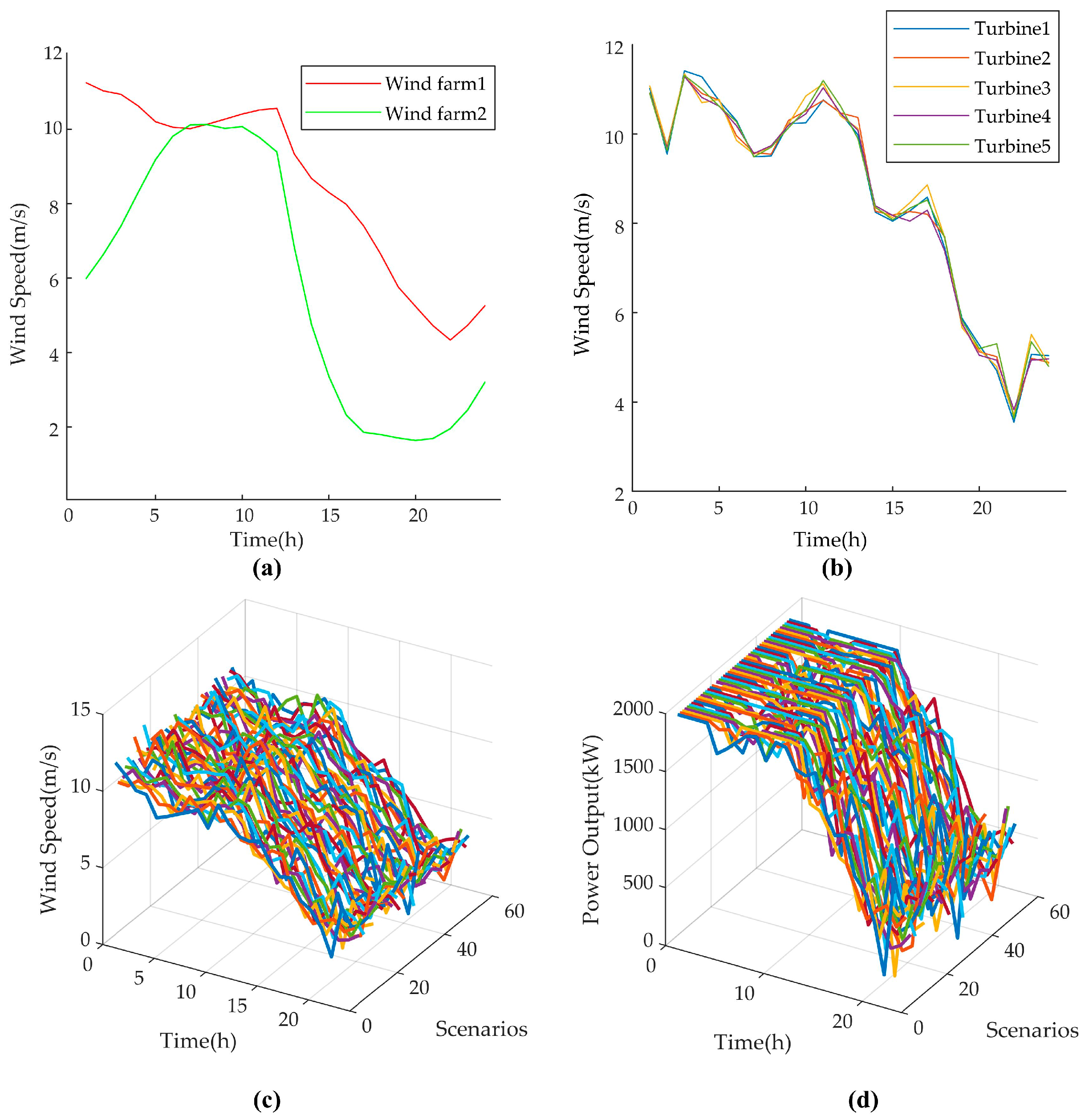


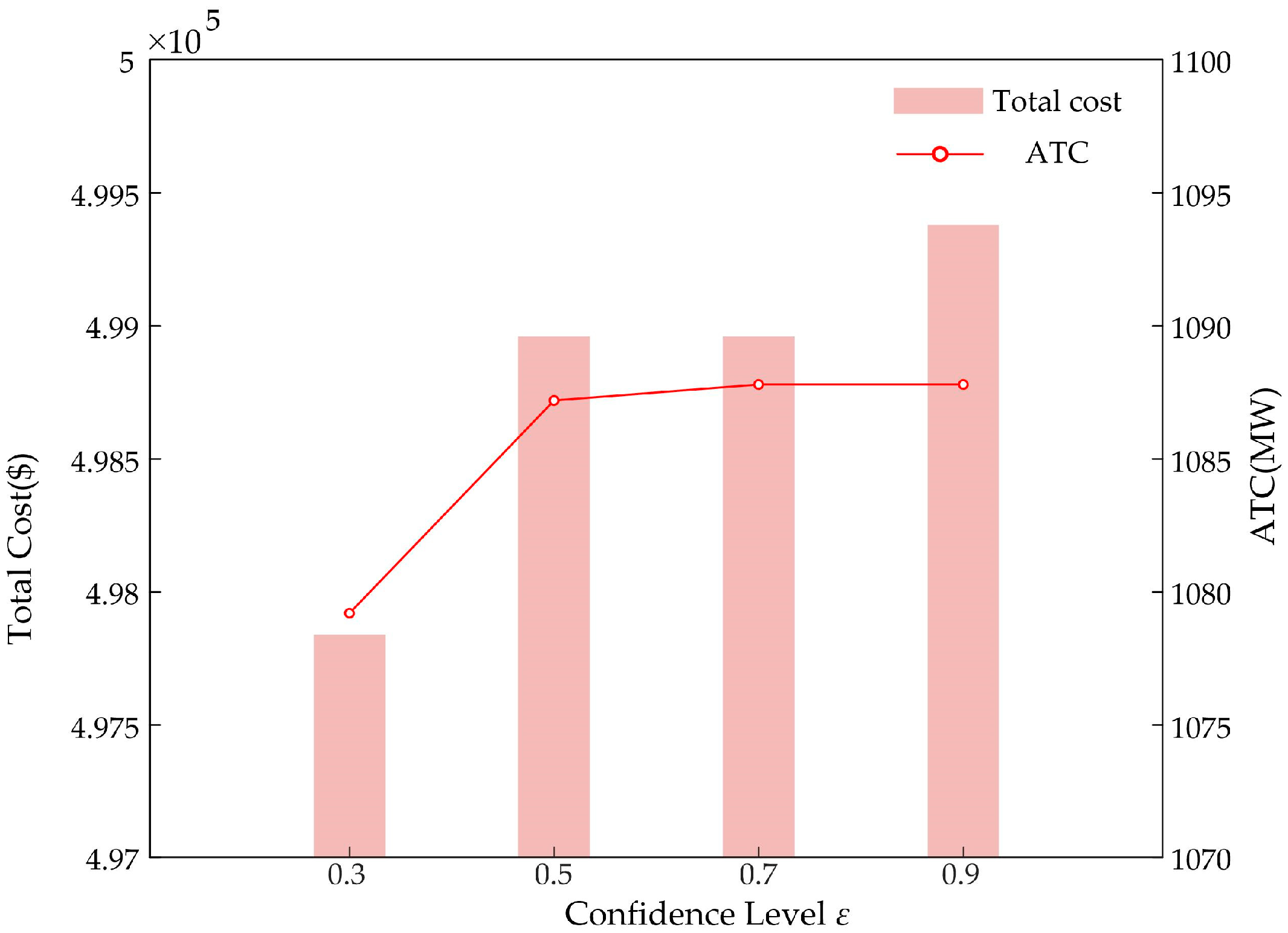
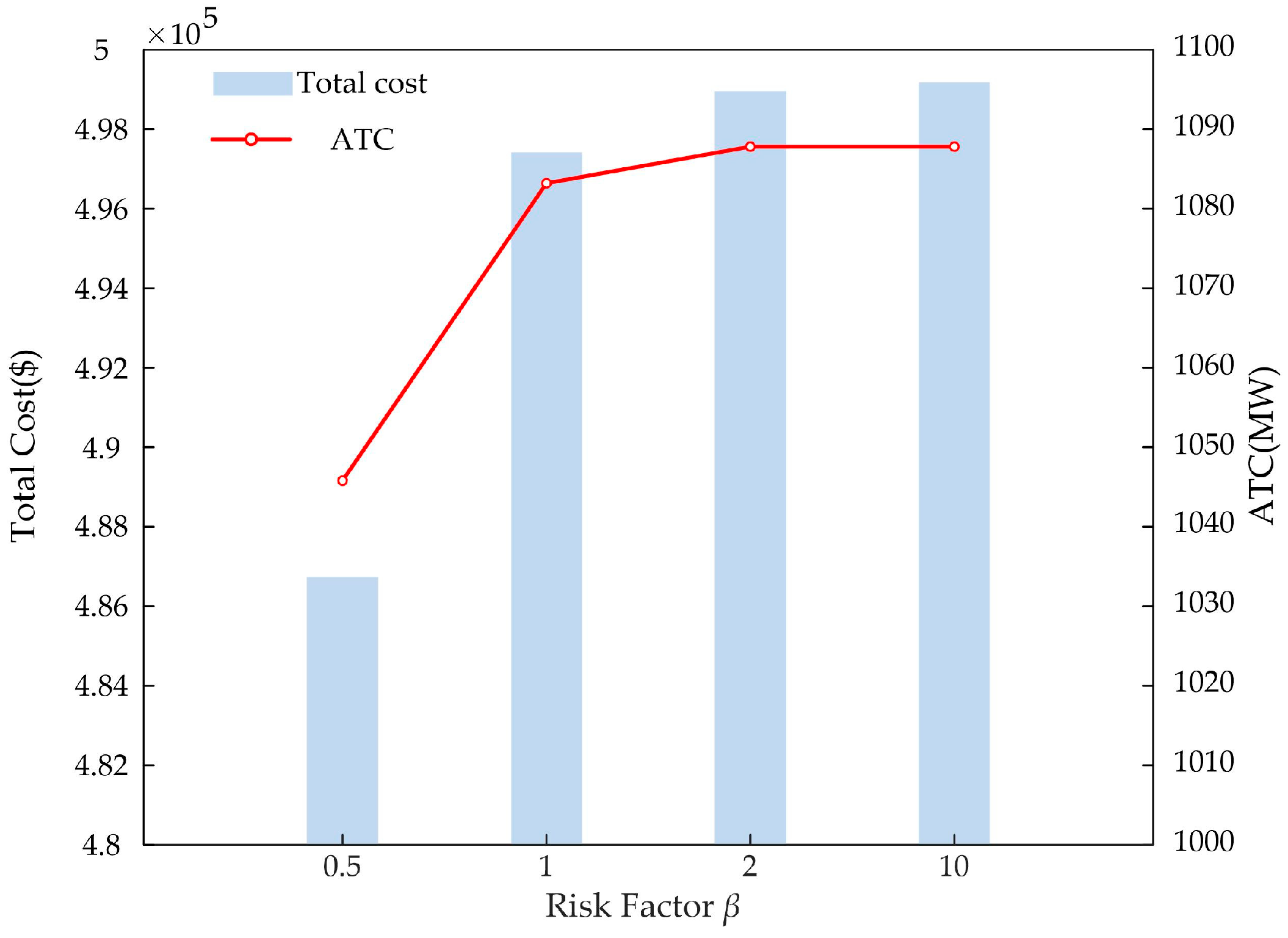

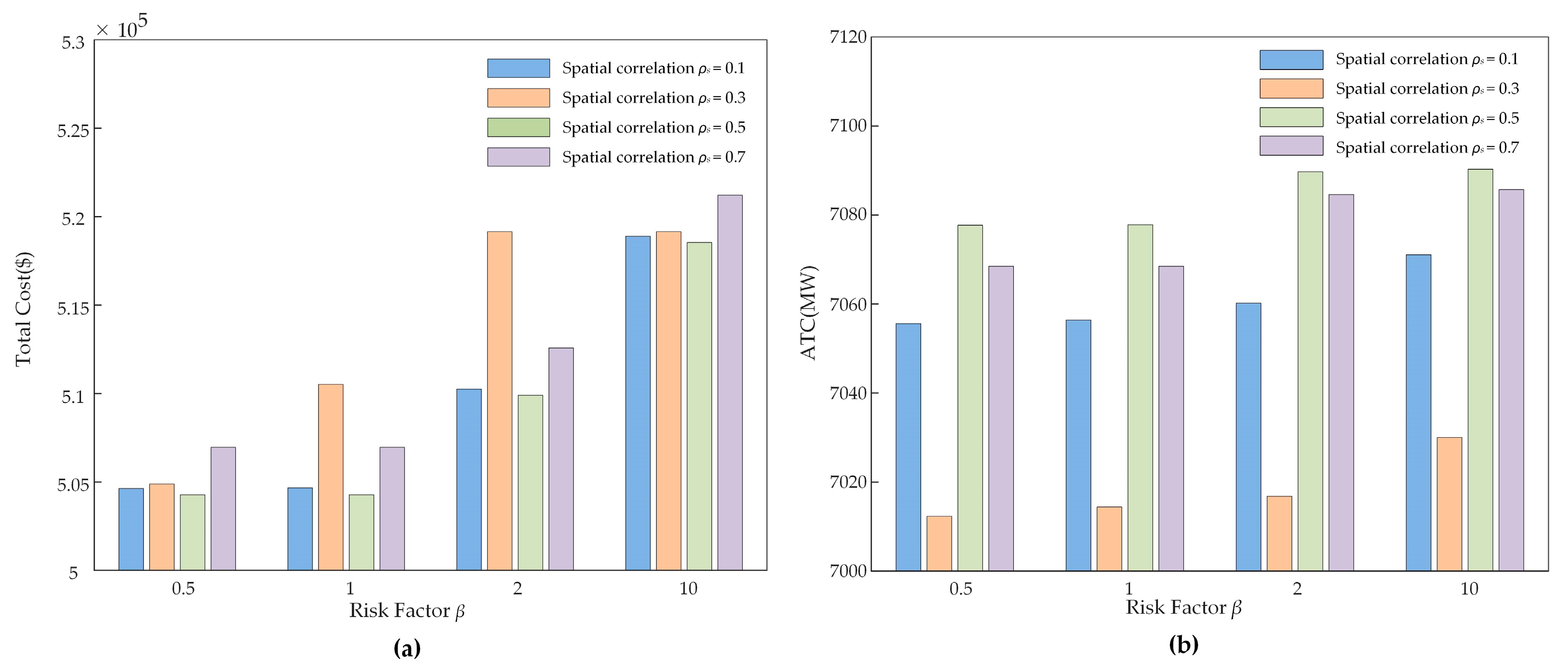
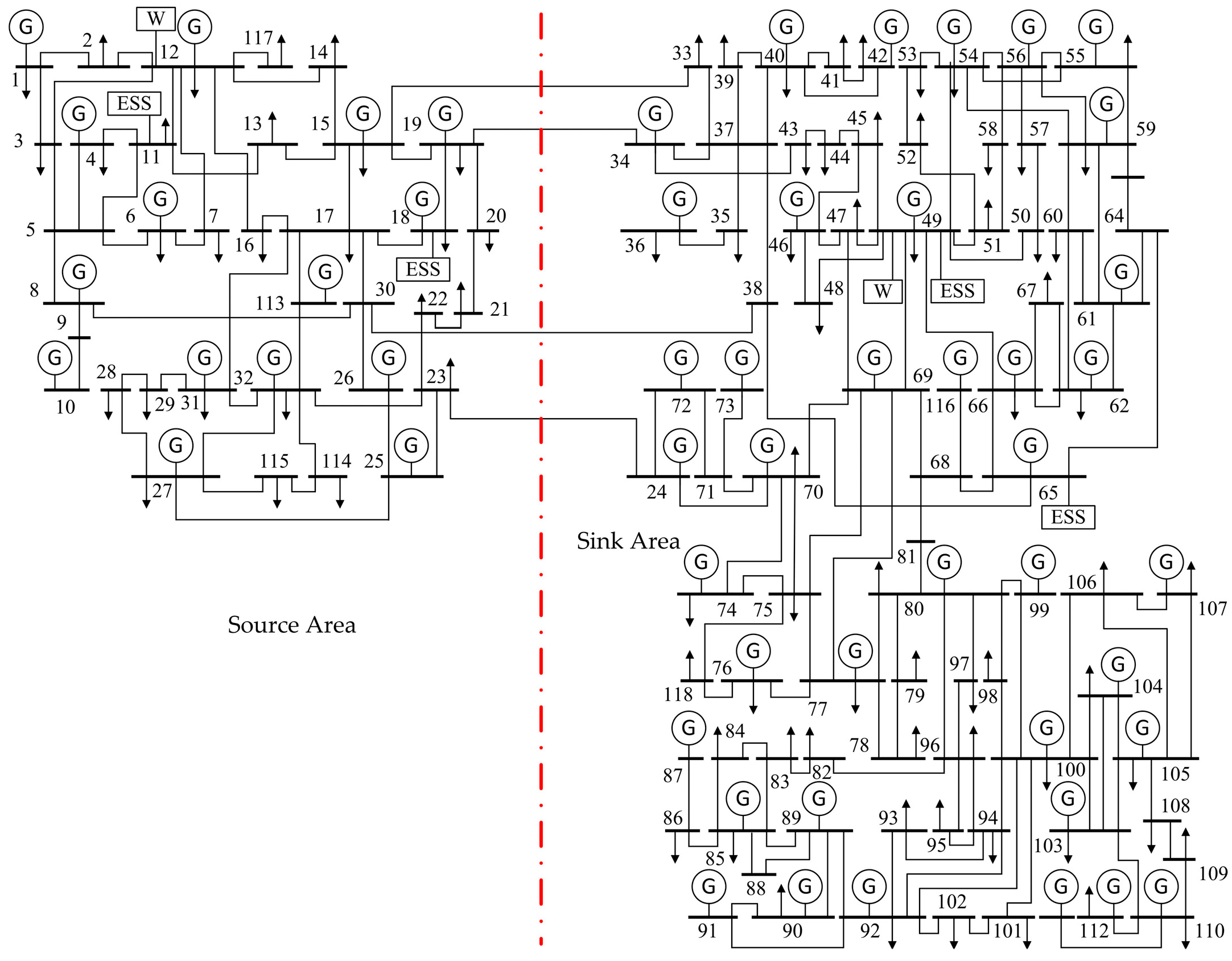

Disclaimer/Publisher’s Note: The statements, opinions and data contained in all publications are solely those of the individual author(s) and contributor(s) and not of MDPI and/or the editor(s). MDPI and/or the editor(s) disclaim responsibility for any injury to people or property resulting from any ideas, methods, instructions or products referred to in the content. |
© 2025 by the authors. Licensee MDPI, Basel, Switzerland. This article is an open access article distributed under the terms and conditions of the Creative Commons Attribution (CC BY) license (https://creativecommons.org/licenses/by/4.0/).
Share and Cite
Xia, S.; Xiong, H.; Dong, Y.; Yan, M.; He, M.; Sima, T. Distributed Privacy-Preserving Stochastic Optimization for Available Transfer Capacity Assessment in Power Grids Considering Wind Power Uncertainty. Mathematics 2025, 13, 3197. https://doi.org/10.3390/math13193197
Xia S, Xiong H, Dong Y, Yan M, He M, Sima T. Distributed Privacy-Preserving Stochastic Optimization for Available Transfer Capacity Assessment in Power Grids Considering Wind Power Uncertainty. Mathematics. 2025; 13(19):3197. https://doi.org/10.3390/math13193197
Chicago/Turabian StyleXia, Shaolian, Huaqiang Xiong, Yi Dong, Mingyu Yan, Mingtao He, and Tianyu Sima. 2025. "Distributed Privacy-Preserving Stochastic Optimization for Available Transfer Capacity Assessment in Power Grids Considering Wind Power Uncertainty" Mathematics 13, no. 19: 3197. https://doi.org/10.3390/math13193197
APA StyleXia, S., Xiong, H., Dong, Y., Yan, M., He, M., & Sima, T. (2025). Distributed Privacy-Preserving Stochastic Optimization for Available Transfer Capacity Assessment in Power Grids Considering Wind Power Uncertainty. Mathematics, 13(19), 3197. https://doi.org/10.3390/math13193197





